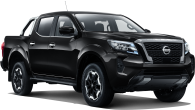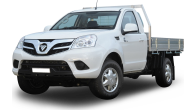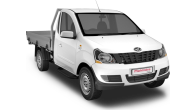As fussy Nannas do with grubby grandchildren, Mazda has gone to work on its BT-50's face as if with a spit-soaked hanky, and has also cleaned up the bum of its popular ute.
With the straighter front grille, a re-design of the front and rear lights and stylish new 16 and 17-inch alloy wheels Grandma Mazda now has the workhorse looking much better.
With 23 variants to choose from in either diesel powered two or four-wheel drive, the BT-50 comes in single cab, freestyle cab and dual cab format in three grades: XT, XTR and GT.
BT-50 comes with the choice of two diesel engine engines including the MZ-CD 2.2-litre 4-cylinder motor and an MZ-CD 3.2-litre 5-cylinder unit, both with either a 6-speed manual or 6-speed automatic transmission.
Prices start at $25,570, plus on road costs, for the 2.2-litre Single Cab/Chassis XT 4x2 manual and round out to $53,790 for the 3.2-litre Dual Cab Utility GT 4X4. The test vehicle, the 3.2-litre Dual Cab Utility XTR 4X4 automatic, slots in at $51,700.
Design
Mazda has come up with a more dynamic shape for the revised BT-50 to reinforce the brand's Zoom-Zoom DNA. Key to this are a powerful front end that inherits elements of the Mazda family face; a profile that represents a revolution in utility architecture; and a rear end that sticks out in the nicest possible way, differentiating the BT-50 from other utes.
The updated BT-50 rolls on newly designed wheels; XTR and GT on 17-inch wheels with a two-tone gunmetal and machined alloy finish, XTR models now have polished tubular side steps, which look flash on the street, but can come a cropper in rough country, where they are invariably the first bit of the vehicle to get bent.
Occupants are kept comfy thanks to dual-zone climate-control air-conditioning, while quality floor covering, leather-wrapped multi-function steering wheel and gear shift knob add a touch of class normally only found in passenger cars.
Measures were taken to suppress noise, vibration and harshness in order to achieve the quiet and comfortable driving experienced in passenger cars.
Features
Mazda XTR and GT models are available with a new centre console layout which includes a 7.8-inch high-definition screen and satellite navigation. HEMA maps are available as an option.
Comfort and convenience extend to the cabin surroundings, which in fit and fixtures match many passenger sedans
An advanced audio system sports six speakers, while all models feature functions typically seen in passenger cars. For example, USB connectivity for portable audio players, Bluetooth connectivity for mobile telephones, and voice control.
Engine
The Mazda 3.2-litre diesel engine has an inline five-cylinder configuration with 20 valves, a turbocharger with an intercooler, and the latest common-rail direct injection technology.
The engine is longitudinally positioned closer to the vehicle's centre of gravity to minimise twisting effect. The greater-than-normal number of cylinders means shorter but consistent combustion intervals and thus limited vibration and noise.
The six-speed automatic transmission of the test vehicle incorporates Sequential Shift Control, which offers Normal and Performance modes plus a Manual mode that allows sequential manual shifting. The Performance mode gives more responsive acceleration. In Manual mode, the driver can select gears as with a manual transmission.
An electronically controlled, shift-on-the-fly transfer case enables the driver to shift between 2WD and 4WD at will via a switch close at hand on the centre console. Low-range gearing is available for extra torque or downhill braking.
Safety
The BT-50 is under the control of a raft of safety technology, including ABS anti-skid braking, dynamic stability control, electronic brake force distribution, emergency brake assist, brake over-ride, hill launch assist, hill descent control, traction control, roll stability control, load adaptive control, trailer sway control and emergency stop signal.
The BT-50 has driver and passenger front airbags, side airbags, and curtain airbags, the last extending as far as the rear seat. The driver's and front passenger seats each have a three-point emergency-locking-retractable seatbelt with a pre-tensioner and a load limiter.
The vehicle is designed to minimise the extent of injuries in the event of contact with a pedestrian.
Driving
The five-cylinder inline 3.2-litre turbo-diesel engine is a no-nonsense unit that goes about its business efficiently and without fuss. Expect to average fuel consumption of 9.5L/100km on the bitumen around the suburbs.
The Performance mode gives more responsive acceleration.
A torque curve with a peak plateau of 470Nm from a low 1750 to 2500rpm provides instant, smooth engine response during take-off and prevents uncomfortable downshifts on sharp acceleration, or when tackling inclines.
A linear steering feel has been dialled in by engineers, with the rigid rack-and-pinion mechanism working more precisely, giving better road feedback. The rear suspension includes a rigid axle with leaf springs, offering superior steering and handling, plus excellent ride comfort.
Comfort and convenience extend to the cabin surroundings, which in fit and fixtures match many passenger sedans running around these days. As a workhorse, the BT-50 is up there with best, with a braked towing capacity of 3500kg, an unbraked capacity of 750kg with a tow ball download of 350kg.
On the downside, the 7.8 inch screen on the test vehicle may have been high definition but its positioning on the upper central dash made it susceptible to reflection in bright sunlight, rendering the images unreadable.
Reversing camera, standard on XTR and GT, and available as an option on all other grades, is not much better, being projected on only a small section of the rear view mirror. Saving grace are sharp, bright coloured guidelines, which come to the rescue in reversing into tight spots.
Mazda BT-50 2016: Xtr (4X4)
| Engine Type | Diesel Turbo 5, 3.2L |
|---|---|
| Fuel Type | Diesel |
| Fuel Efficiency | 8.9L/100km (combined) |
| Seating | 4 |
| Price From | $22,440 - $27,720 |
| Safety Rating |
|
Verdict
With a line-up of almost biblical proportions, the BT-50 has something for everyone and should continue to maintain its place in the upper echelons of Mazda's product range.
How does the BT-50 stack up against the Hilux, Navara and Ranger? Tell us what you think in the comments below.
Click here to see more 2016 Mazda BT-50 pricing and spec info.
Pricing Guides

Range and Specs
| Vehicle | Specs | Price* |
|---|---|---|
| Xt (4X2) | 3.2L, Diesel, 6 SPEED AUTOMATIC | $15,620 - $20,020 |
| Xt (4X2) | 3.2L, Diesel, 6 SPEED MANUAL | $13,640 - $17,930 |
| Xt (4X4) | 3.2L, Diesel, 6 SPEED AUTOMATIC | $18,480 - $23,430 |





.jpg)
.jpg)
.jpg)
.jpg)
.jpg)
.jpg)
.jpg)
.jpg)
.jpg)
.jpg)
.jpg)
.jpg)
.jpg)
.jpg)

.jpg)
.jpg)
.jpg)







.jpg)
.jpg)



